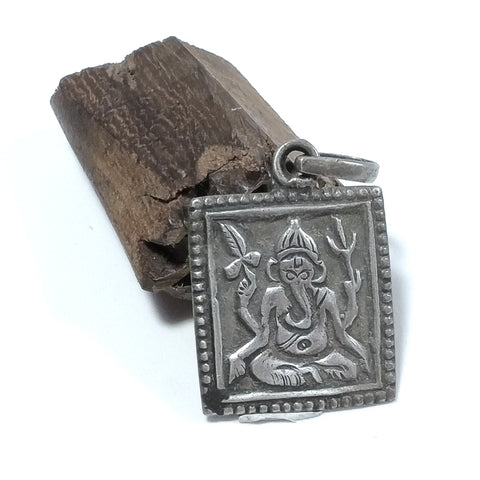GANESH - removes obstacles

The Lord of Good Auspiciousness
In general terms, Ganesha is a much loved and invoked deity, since he is the Lord of good omen who gives prosperity and luck, the Destroyer of material or spiritual obstacles; for this reason its grace is invoked before starting any activity, such as a trip, an exam, a job interview, a business deal, a ceremony, or any important event. For this reason it is traditional for all bhajan (devotional singing) sessions to begin with an invocation to Ganesha, Lord of the "good beginning" of songs.
It is also associated with the first chakra, which represents the instinct of conservation and survival, procreation and material well-being.
Each element of Ganesha's body has its own value and meaning:
the elephant head indicates loyalty, intelligence and discriminating power;
the fact that he has only one tusk (and the other broken) indicates the ability to overcome any dualism;
large ears denote wisdom, ability to listen and reflect on spiritual truths;
the curved proboscis indicates the intellectual potential, which manifests itself in the faculty of discrimination between real and unreal;
on his forehead he depicted the Trident (symbol of Shiva), which symbolizes Time (past, present and future) and attributes its mastery to Ganesha;
the obese belly is such because it contains infinite universes, it also represents equanimity, the ability to assimilate any experience with serene detachment, without getting upset in the slightest;
the leg resting on the ground and the one raised indicate the attitude one should take when participating in material and spiritual reality, or rather the ability to live in the world without being of the world;
the four arms of Ganesha represent the four internal attributes of the subtle body, namely: mind, intellect, ego, conditioned consciousness;
in one hand he brandishes an axe, symbol of the cutting off of all desires, which bring suffering;
in the second hand he holds a lasso, symbol of the strength that binds the devotee to the eternal bliss of the Self;
the third hand, facing the devotee, is in an act of blessing (abhaya);
the fourth hand holds a lotus flower (padma), which symbolizes the highest goal of human evolution.
The broken fang
Ganesha's broken fang, as we have seen, primarily indicates the ability to overcome or "break" duality; however, this is a symbol that can take on various meanings.
« An elephant usually has two tusks. Even the mind often proposes two alternatives: the good one and the bad one, the excellent and the expedient, the fact and the fantasy that leads it astray. To do anything, the mind must still become determined. Lord Ganesha's elephant head therefore has only one tusk, hence He is called "Ekadantha", meaning "He who has only one tusk", to remind everyone that one must possess mental determination. »
sathja sai baba
There are various anecdotes that explain the origin of this particular attribute (see paragraph How did Ganesha's tusk break?).
Ganesha and the Mouse
Ganesha's mount is a small mouse (Mushika or Akhu), which represents the ego, the mind with all its desires, the greed of the individual; Ganesha, riding the mouse, becomes master (and not slave) of these tendencies, indicating the power that intellect and discrimination have on the mind. Furthermore, the mouse (extremely voracious by nature) is often depicted next to a plate of sweets, looking towards Ganesha while holding a morsel tightly between its paws, as if waiting for his order; it represents the mind that has been completely subjected to the superior faculty of the intellect, the mind subjected to an iron control, which fixes Ganesha and does not approach food unless it receives permission.
Married or single?
It is interesting to note how, according to tradition, Ganesha was generated by Mother Parvati without the intervention of her husband Śiva; in fact Śiva, being eternal (Sadashiva), did not feel any need to have children. Thus Ganesha was born from Parvati's unique feminine desire to create. As a result, Ganesha's relationship with his mother is unique and special.
This devotion is the reason why South Indian tradition represents him as celibate (see the anecdote Devotion to the Mother). It is said that Ganesha, considering his mother Parvati the most beautiful and perfect woman in the universe, exclaimed: "Bring me a woman as beautiful as her and I will marry her."
In northern India, however, Ganesha is often depicted married to the two daughters of Brahma: Buddhi (intellect) and Siddhi (spiritual power). In other depictions her consorts are Sarasvathi (goddess of culture and art) and Lakshmi (goddess of luck and prosperity), symbolizing that these qualities always accompany those who have discovered their own inner Divinity.
source: wikipedia














